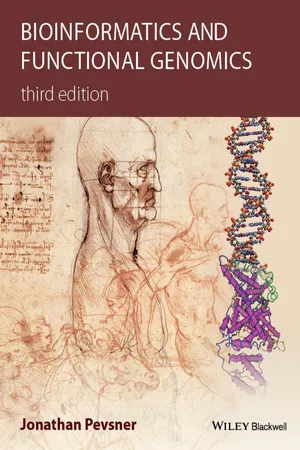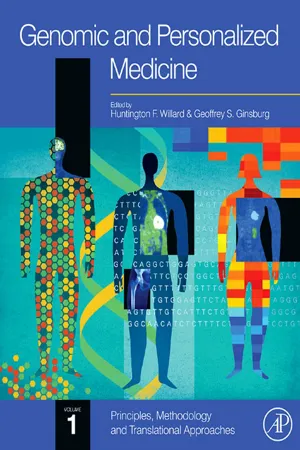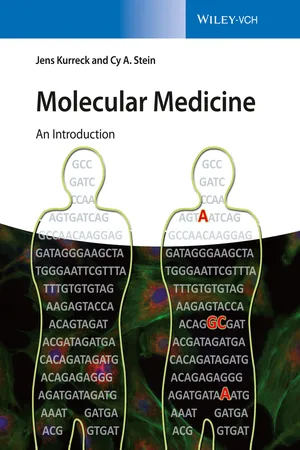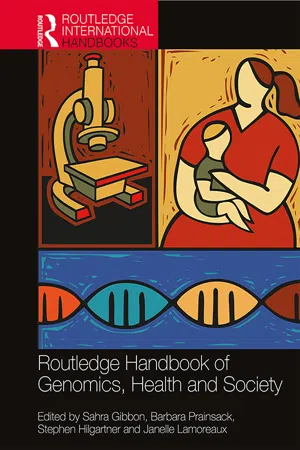Biological Sciences
Genome Projects
Genome projects involve the mapping and sequencing of an organism's complete set of DNA, known as its genome. These projects aim to identify and understand the genetic makeup of organisms, including humans, plants, and animals. The data generated from genome projects provides valuable insights into the genetic basis of traits, diseases, and evolutionary relationships.
Written by Perlego with AI-assistance
Related key terms
6 Key excerpts on "Genome Projects"
- eBook - ePub
- Jonathan Pevsner(Author)
- 2015(Publication Date)
- Wiley-Blackwell(Publisher)
This project would greatly increase our understanding of human biology and allow rapid progress to occur in the diagnosis and ultimate control of many human diseases. As visualized, it would also lead to the development of a wide range of new DNA technologies and produce the maps and sequences of the genomes of a number of experimentally accessible organisms, providing central information that will be important for increasing our understanding of all biology.— National Research Council (1988, p. 11).LEARNING OBJECTIVES
After studying this chapter you should be able to:- describe the main features of the human genome;
- provide an overview of all the human chromosomes, giving a general description of their size, number of genes, and key features; and
- explain the purpose and main conclusions of several key human genome efforts including the HapMap Project and 1000 Genomes Projects.
INTRODUCTION
The human genome is the complete set of DNA in Homo sapiens. This DNA encodes the proteins and other products that define our cells and ultimately define who we are as biological entities. Through the genomic DNA, protein-coding genes are expressed that form the architecture of the trillions of cells that comprise each of our bodies. It is variations in the genome that in large part account for the differences between people, from physical features to personality to disease states.The initial sequencing of the human genome in 2003 was a triumph of science. It followed 50 years exactly after the publication of the double-stranded helical structure of DNA by Crick and Watson (1953). The genome sequence was achieved through an international collaboration involving hundreds of scientists. (In the case of the publicly funded version, this was the International Human Genome Sequencing Consortium (IHGSC), described in “Human Genome Project” below.) This project could not have been possible without fundamental advances in the emerging fields of bioinformatics and genomics.In this chapter we first summarize some of the major findings of the human genome project. Second, we review resources for the study of the human genome at three sites: the National Center for Biotechnology Information (NCBI); the Ensembl project; and the genome center at the University of California, Santa Cruz. - eBook - ePub
- James Chambers, James Chambers(Authors)
- 2019(Publication Date)
- Omnigraphics(Publisher)
Part Five Genetic Research Chapter 61 The Human Genome Project What Is a Genome?A genome is an organism’s complete set of deoxyribonucleic acid (DNA), including all of its genes. Each genome contains all of the information needed to build and maintain that organism. In humans, a copy of the entire genome—more than three billion DNA base pairs—is contained in all cells that have a nucleus.What Was the Human Genome Project and Why Has It Been Important?The Human Genome Project (HGP) was an international research effort to determine the sequence of the human genome and identify the genes that it contains. The project was coordinated by the National Institutes of Health (NIH) and the U.S. Department of Energy (DOE). Additional contributors included universities across the United States and international partners in the United Kingdom, France, Germany, Japan, and China. The HGP formally began in 1990 and was completed in 2003, two years ahead of its original schedule.The work of the HGP has allowed researchers to begin to understand the blueprint for building a person. As researchers learn more about the functions of genes and proteins, this knowledge will have a major impact in the fields of medicine, biotechnology, and the life sciences.What Were the Goals of the Human Genome Project?The main goals of the HGP were to provide a complete and accurate sequence of the 3 billion DNA base pairs that make up the human genome and to find all of the estimated 20,000 to 25,000 human genes. The project also aimed to sequence the genomes of several other organisms that are important to medical research, such as the mouse and the fruit fly.In addition to sequencing DNA, the HGP sought to develop new tools to obtain and analyze the data and to make this information widely available. Also, because advances in genetics have consequences for individuals and society, the HGP committed to exploring the consequences of genomic research through its Ethical, Legal, and Social Implications (ELSI) program. - eBook - ePub
- (Author)
- 2008(Publication Date)
- Academic Press(Publisher)
For the first time, investigator-driven projects will be funded in addition to the continued support of network initiatives (European Commission, 2002). The field of genome sciences has already taken the next step forward toward applying this new knowledge and capability to medically relevant initiatives. For example, the NIH Chemical Genomics project involves the development of a public repository of small organic molecules to study cellular pathways in health and disease and hasten the identification of new drug targets and drug development (NIH Chemical Genomics Center, 2005). The Medical Sequencing Project involves the sequencing of well-phenotyped patients with autosomal and X-linked Mendelian diseases as well as common diseases to identify the underlying genetic cause of disease (National Human Genome Research Institute, 2007). With respect to diagnostic screening and testing, the emphasis on translational research has provided opportunities to gather data about the clinical utility of new tools. Demonstrating clinical validity and utility is critical to the development of clinical guidelines and reimbursement policies that will support the appropriate use of these tests. For example, the National Cancer Institute is supporting a long-term prospective study called The Trial assigning Individualized Options for Treatment (Rx), or TAILORx (National Cancer Institute, 2006). This study will explore whether an expression profile of 16 genes associated with risk of recurrence for women with early stage breast cancer is useful in identifying those women who will most likely benefit from chemotherapy in addition to radiation and hormonal therapy. The study will follow 10,000 women for a period of 10 years, with follow-up of up to 20 years after initial therapies - eBook - ePub
- Peter Glasner, Paul Atkinson, Helen Greenslade, Peter Glasner, Paul Atkinson, Helen Greenslade(Authors)
- 2006(Publication Date)
- Routledge(Publisher)
The project’s new research strategies and experimental technologies have generated a steady stream of ever-larger and more complex genomic data sets that have poured into public databases and have transformed the study of virtually all life processes. The genomic approach of technology development and large-scale generation of community resource data sets has introduced an important new dimension into biological and biomedical research. . . . Genome sequences, the bounded sets of information that guide biological development and function, lie at the heart of this revolution. In short, genomics has become a central and cohesive discipline of biomedical research.(Collins et al. 2003: 835)At the ‘heart of this revolution’ are genome sequences, and it is the reproduction of this type of resource – large-scale ‘omic’ data sets available to the community in public databases – that is transforming biological and biomedical research into a genomics discipline. Furthermore, as the building suggests, the genomic era is not just about the realignment of biology and medicine in accordance with the genomics discipline, but the genomic disciplining of society.Drawing on lessons from the HGP, the authors identify six ‘elements’ that are necessary for the reproduction of the genomics discipline. These are depicted as six vertical columns that rise through all three floors, crosscutting the three themes. For each theme, the authors identify a number of ‘grand challenges’. The entire framework for Collins et al.’s vision of the genomic era is summarised in Table 14.1, the organisation of which is based on the architecture of the building.One way of conceptualising this vision is as one whose core goal is the ‘generation of large publicly available comprehensive’ sets of data. From this perspective, its themes and grand challenges can be read as ever more ambitious expressions of this core goal, and its cross-cutting elements can be seen as the conditions of possibility for its realisation.Theme I, Genomics to Biology, starts with the compilation of the DNA-based genome ‘parts list’ (GC I.1),10 and then progresses to the generation of experimentally derived data sets of genetic networks, proteins and protein pathways (GC I.2). Understanding the relationship between genotype and individual variation in biological function (GC I.3) requires projects such as the International HapMap Project to catalogue all common DNA variants in the human population.11 For establishing and assessing the risks that particular gene variants contribute to health, disease susceptibility and drug response, large, longitudinal, population-based cohort studies such as the UK Biobank, Marshfield Clinic’s Personalized Medicine Research Project and the Estonian Genome Project are recommended (GC II.1, II.2).12 - eBook - ePub
Molecular Medicine
An Introduction
- Jens Kurreck, Cy Aaron Stein(Authors)
- 2015(Publication Date)
- Wiley-Blackwell(Publisher)
7 Genomics and Proteomics Contents List- Whole Genome Sequencing
- Cloning of a Genome
- Mapping and Assembly of the Genome
- Sequencing of a Large Genome
- The Human Genome
- Sequencing of the Human Genome
- The International HapMap Project
- The 1000 Genomes Project and the Personal Genome Project
- Encyclopedia of DNA Elements (ENCODE)
- Proteomics
- Two-Dimensional Gel Electrophoresis and Mass Spectrometry
- Quantitative and Shotgun Proteomics
- Structural Proteomics
Summary
- The Human Genome Project (HGP) was launched in 1990 to elucidate the sequence of the more than 3 billion bases of the haploid human genome. The publicly funded project used an ordered shotgun approach. Celera, a competing company, applied the whole genome shotgun strategy to human genome sequencing. Both projects simultaneously reported the complete sequence of the human genome, which has become an indispensable part of biomedical research and development. One of the surprising results of the sequence analysis was that the number of proteins encoded in the human genome is between 20 000 and 25 000, much lower than previously thought.
- Following the HGP, various large-scale, worldwide projects have been initiated to further understand the human genome. Several of these projects investigate variations in the human genome and their relevance to human health and disease. Thousands of genomes have been sequenced. The genomes of two unrelated human individuals differ by approximately 0.1%. Approximately 40 million single-nucleotide polymorphisms (SNPs) have been discovered, epigenetic patterns have been elucidated, and genomes of various tumor types have been sequenced.
- The Encyclopedia of DNA Elements (ENCODE) project aims to identify all the functional elements in the human genome. It revealed that at least 80% of the human genome is presumed to have biological function, although most of the information contained in the DNA is not translated into proteins. A large fraction of the genome is transcribed into noncoding RNAs (ncRNAs) with regulatory functions. Many functional elements at the DNA level play an important role in the modulation of gene expression. These findings reverse the traditional view that more than 98% of the human genome does not encode proteins and can thus be regarded as “junk.”
- Sahra Gibbon, Barbara Prainsack, Stephen Hilgartner, Janelle Lamoreaux, Sahra Gibbon, Barbara Prainsack, Stephen Hilgartner, Janelle Lamoreaux(Authors)
- 2018(Publication Date)
- Routledge(Publisher)
In the second half of the 1980s, an elite group of scientists set out to make entire genomes into tractable objects of biological analysis. Envisioning themselves as a scientific vanguard that would spearhead a revolution in the biological sciences and medicine, they sought to catalyze a “paradigm shift” in biology. The centerpiece of their scientific proposals was the Human Genome Project (HGP) – a concerted effort to map and sequence the genomes of the human and several model organisms; advance genome technology; and develop new tools for computational analysis. Their vision of revolutionary change captured imaginations and resources, and before the end of the decade, the U.S. Congress had committed $3 billion to the HGP, a joint project of the National Institutes of Health (NIH) and Department of Energy (DOE) (Cook-Deegan 1994). Smaller genome programs of varying configurations took shape in Europe and Japan (Jordan 1992). The prospect of transformational change – in biological research, medicine, and many aspects of everyday life – raised problems of governance (Hilgartner 2017). How could decision makers govern the “genomics revolution” in ways that realized its promised benefits while minimizing its potential for harm?In 1988, James D. Watson, the newly appointed director of the NIH genome program, proposed an answer; namely, to devote 3 percent of the HGP budget to studying the ethical and social implications of genome research. Beyond ensuring that “society learns to use the information only in beneficial ways,” Watson (1990, 46) warned about the possibility that failure to act could lead to “abuses,” provoking a “strong popular backlash against the human genetics community.” With the United States poised to spend some $3 billion over a fifteen-year period on the HGP, Watson’s commitment promised to make what soon became the genome project’s Ethical, Legal, and Social Implications (ELSI) program into the best funded bioethics enterprise in history. By 2014, the U.S. ELSI Program had provided $317 million in research support (McEwen et al. 2014).
Index pages curate the most relevant extracts from our library of academic textbooks. They’ve been created using an in-house natural language model (NLM), each adding context and meaning to key research topics.





